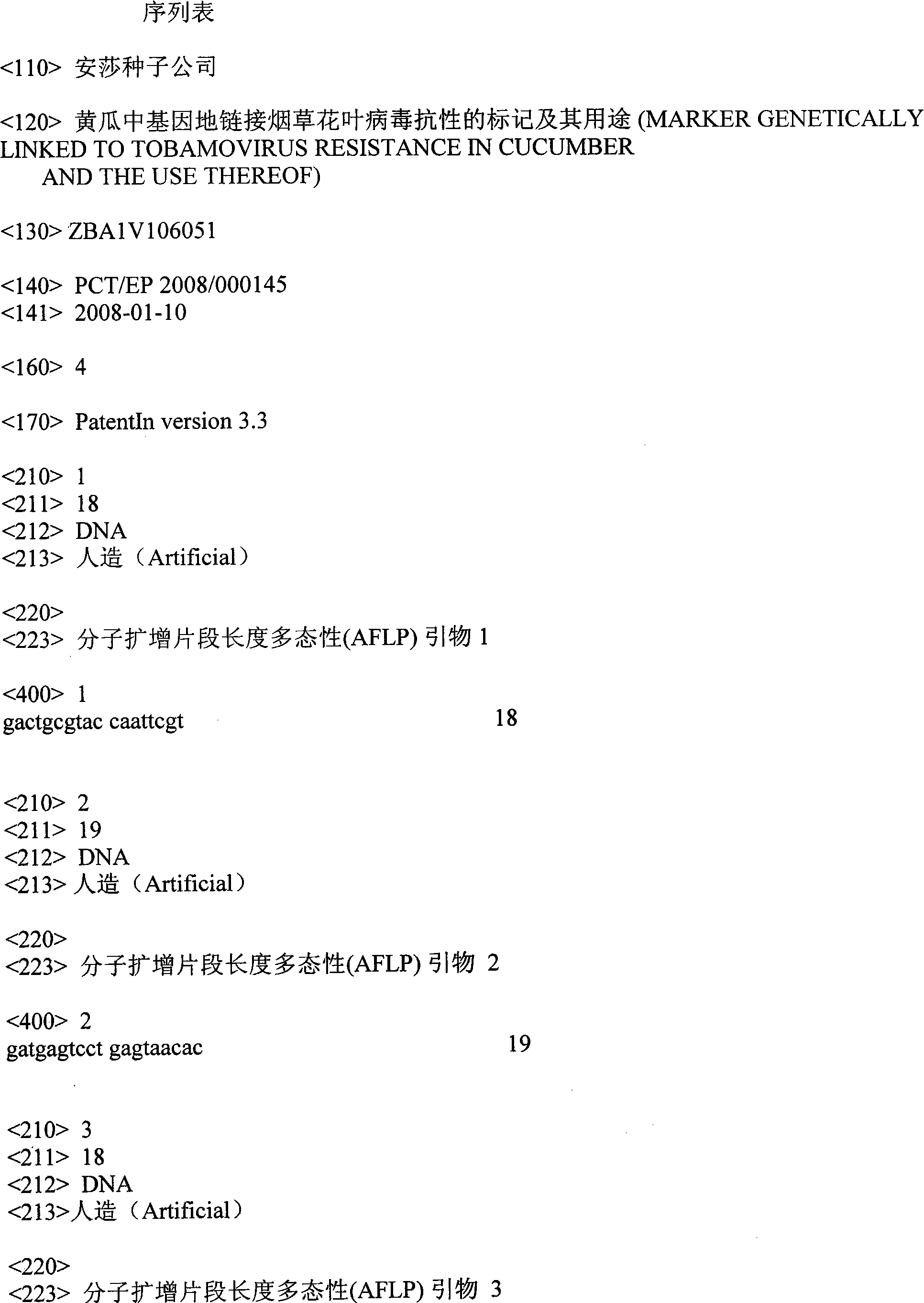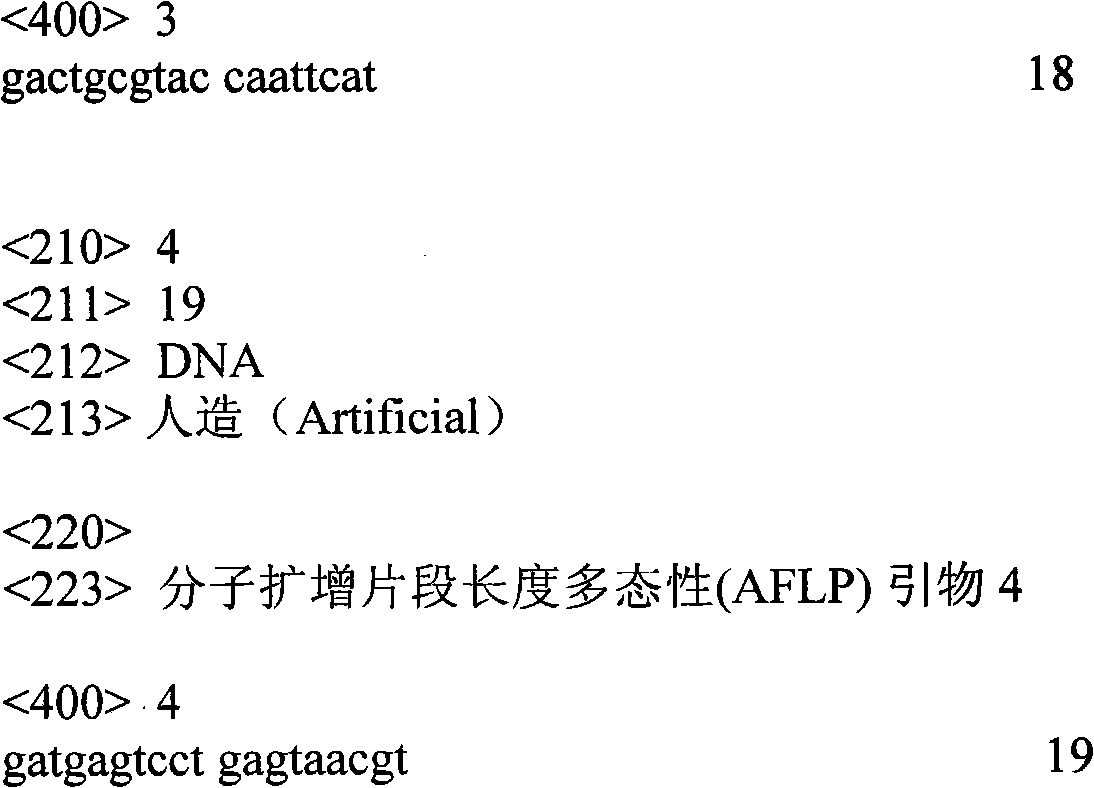Marker genetically linked to tobamovirus resistance in cucumber and the use thereof
A technology for tobacco mosaic virus and cucumber, applied in the direction of plant genetic improvement, application, angiosperms/flowering plants, etc., can solve problems such as crop loss, and achieve the effect of avoiding cumbersome and expensive, and avoiding screening methods.
- Summary
- Abstract
- Description
- Claims
- Application Information
AI Technical Summary
Method used
Image
Examples
Embodiment 1
[0044] Example 1: Introduction to the identification of sensitive and resistant cucumber plants (Cucumis sativus L.)
[0045] The following experimental plan was used to classify cucumber plants (Cucumis sativus L.) as susceptible or resistant to cucumber green mottle mosaic virus (CGMMV) and cucumber fruit mottle mosaic virus (CFMMV) infection. At least in the Netherlands, the best time to implement analytics is from September to April.
[0046] plant material
[0047] The tested plants (Cucumis sativus L.), both resistant and sensitive, were sown in medium-sized vermiculites and grown at 24°C, covered with small-sized vermiculites. After 4 to 5 days (cotyledons had just unfolded), the seedlings were transferred to asbestos blocks, and after 2 days the plants were transferred to an isolated greenhouse.
[0048] After each block of 40 individuals, preferably 4 days after placing them in an isolated greenhouse, the sensitivity control Tyria F1 (commercial F1 cucumber variety ...
Embodiment 2
[0055] Example 2: Identification of AFLP markers to identify a QTL for tobacco mosaic virus resistance
[0056] introduce
[0057] In this example, quality trait loci (QTLs) were identified in resistant cucumber plants (Cucumis sativus L.) using a bulk QTL analysis (BQA) performed by Keygene N.V (Wageningen, The Netherlands). A population of 98 individuals was selected for marker development of tobacco mosaic virus resistance. A total of 96 AFLP primer combinations were screened in two pools containing individuals with the "extreme phenotype" showing resistance to tobacco mosaic virus. Subsequently, 5 candidate markers were validated on 12 resistant and 12 sensitive individuals.
[0058] Mark identification and verification
[0059] The leaf materials of 130 plants were obtained: the Cuc1879-01×OK561 population of 98 individuals provided the population for the test, and the inbred line of 30 donor parents Cuc1879-01 and the male line of the population. DNA is isolated and ...
Embodiment 3
[0073]Example 3: Identification of Tobacco Mosaic Virus-Resistant Cucumber Plants (Cucumis sativus L.) Assisted by Molecular Markers
[0074] molecular analysis
[0075] Genetic material was isolated from susceptible and resistant cucumber plants (Cucumis sativus L.), ie, exhibiting one or more symptoms of viral infection as described above, using standard experimental protocols.
[0076] Next, this gene material is digested with an appropriate restriction enzyme (EcoRI / MseI), and after ligation of the linker, the primer pair SEQNo: 1 5-GAC TGC GTA CCA ATT CGT-3' and SEQIDNo: 2 5'-GAT GAG TCC TGA GTA ACA C-3' or primer pair SEQID No: 3 5'-GACTGC GTA CCA ATT CAT-3' and SEQ ID No: 4 5'-GAT GAG TCC TGA GTA ACGT-3' for AFLP nucleic acid amplification.
[0077] The resulting amplification product was sized by electrophoresis. The presence of the AFLP marker in the genes of independent cucumber plants (Cucumis sativus L.) could be detected as absence (-) or presence (+).
[0078]...
PUM
 Login to View More
Login to View More Abstract
Description
Claims
Application Information
 Login to View More
Login to View More - R&D
- Intellectual Property
- Life Sciences
- Materials
- Tech Scout
- Unparalleled Data Quality
- Higher Quality Content
- 60% Fewer Hallucinations
Browse by: Latest US Patents, China's latest patents, Technical Efficacy Thesaurus, Application Domain, Technology Topic, Popular Technical Reports.
© 2025 PatSnap. All rights reserved.Legal|Privacy policy|Modern Slavery Act Transparency Statement|Sitemap|About US| Contact US: help@patsnap.com


